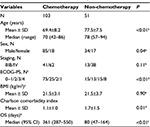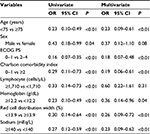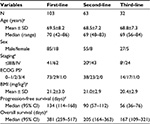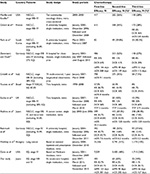Back to Journals » Lung Cancer: Targets and Therapy » Volume 7
Outcomes and prognostic factors of chemotherapy for patients with locally advanced or metastatic pulmonary squamous cell carcinoma
Authors Minami S , Ogata Y, Ihara S, Yamamoto S, Komuta K
Received 1 March 2016
Accepted for publication 28 June 2016
Published 24 August 2016 Volume 2016:7 Pages 99—110
DOI https://doi.org/10.2147/LCTT.S107560
Checked for plagiarism Yes
Review by Single anonymous peer review
Peer reviewer comments 3
Editor who approved publication: Prof. Dr. Pan-Chyr Yang
Seigo Minami, Yoshitaka Ogata, Shouichi Ihara, Suguru Yamamoto, Kiyoshi Komuta
Department of Respiratory Medicine, Osaka Police Hospital, Osaka, Japan
Background: Pulmonary squamous cell carcinoma has not benefited from improvements in chemotherapy over the past decade, compared with non-squamous non-small-cell lung cancer. Nowadays, treatment strategies differ between squamous and non-squamous non-small-cell lung cancers. This study aimed to investigate the percentage of patients treated with first-, second-, or third-line chemotherapy and the characteristics of patients for whom chemotherapy has been beneficial.
Method: Data on patients with stage IIIB or IV squamous cell carcinoma diagnosed between June 2007 and March 2015, and on patients who had received first-, second-, or third-line chemotherapy between June 2007 and November 2015 at our hospital, were retrospectively extracted from our institutional medical charts. We also compared patients who were treated with chemotherapy (chemotherapy group) and patients who were not (non-chemotherapy group) using multivariate logistic regression and multivariate Cox hazard analyses, respectively.
Results: During the study period, 103, 63, and 32 patients received first-, second-, and third-line chemotherapy, respectively. Fifty-one patients did not receive chemotherapy. Factors predicting unlikely chemotherapy included age ≥75 years, Eastern Cooperative Oncology Group (ECOG)-performance status (PS) ≥2, Charlson comorbidity index ≥2, hemoglobin <12.2 g/dL, red cell distribution width ≥13.9%, and serum sodium <140 mEq/L. Factors predicting survival for each line of chemotherapy included the following: ECOG-PS ≥2 for first-line; ECOG-PS ≥2 and lymphocyte count for second-line; and ECOG-PS ≥2, body mass index <18.5 kg/m2, and hemoglobin and lactate dehydrogenase levels for third-line.
Conclusion: Approximately 66% of patients received first-line chemotherapy. Of those, 66% and 33% received second- and third-line chemotherapy, respectively. ECOG-PS was always an essential prognostic factor when considering introducing chemotherapy and proceeding with additional chemotherapy. Other markers, such as lymphocyte count, body mass index, anemia, and lactate dehydrogenase level, may be useful depending on the patient and line of chemotherapy.
Keywords: squamous cell carcinoma, non-small-cell lung cancer, first-line chemotherapy, second-line chemotherapy, third-line chemotherapy, prognostic factors
Introduction
Pulmonary squamous cell carcinomas, for which incidence rates are on the decline in Japan possibly owing to declining trends in smoking prevalence, still account for 35% and 16% of Japanese cases in men and women, respectively.1 Over the last decade, some promising antitumor drugs and personalized therapies based on genetic information have been developed for non-squamous non-small-cell lung cancer (NSCLC). In contrast, squamous cell carcinoma has been left behind in terms of new chemotherapies and treatments. Today, treatment strategies differ markedly between squamous and non-squamous NSCLCs.
For patients with advanced NSCLC, chemotherapy is still a standard treatment option. However, except for patients with NSCLC harboring specific gene mutations, older patients, and patients with poor performance status (PS), platinum-based combination regimens are recommended as the standard first-line treatment for advanced NSCLC. However, almost all patients experience progression during or after first-line chemotherapy, and some of them require salvage chemotherapy. Some single- and multi-institutional and database-based survey studies have reported that patients with advanced NSCLC have received best supportive care (BSC) alone, or first- and later-line chemotherapy. With the exception of a study based on data from the US Medicare database,2 there is no other study that has focused on patients with squamous cell carcinoma and followed their course of chemotherapy.
Our retrospective study focused on squamous cell carcinoma and aimed to investigate 1) the percentage of patients treated with first-, second-, or third-line chemotherapy and 2) the types of patients for whom chemotherapy had been beneficial.
Methods
Patients and study design
This study was a single-institution retrospective study performed at the Osaka Police Hospital. First, to investigate predictive markers distinguishing the chemotherapy group from the non-chemotherapy group, we extracted data on patients who were histologically or cytologically diagnosed with stage IIIB or IV pulmonary squamous cell carcinomas between June 2007 and March 2015. We excluded patients who had transferred to other hospitals to receive aggressive treatment, and patients with squamous cell carcinomas combined with other histological types. We compared patients who were treated with chemotherapy (chemotherapy group) with patients who were not treated with chemotherapy (non-chemotherapy group). Second, to investigate prognostic markers of each line of chemotherapy, we retrospectively abstracted three cohorts of patients who had initiated first-, second-, or third-line chemotherapy between June 2007 and November 2015 at our hospital. We excluded patients who had received front-line chemotherapy at another hospital and then transferred to our hospital and received later-line chemotherapy.
Extraction of data, criteria for the evaluable population for overall response rate (RR), and definitions of overall RR, overall survival (OS), and progression-free survival (PFS) were as previously described.3 Laboratory data obtained from venous samples included absolute leukocyte count, neutrophil count, lymphocyte count, monocyte count, hemoglobin level, red cell distribution width (RDW) coefficient of variation (measured using a method that shows heterogeneity in erythrocyte size, which has been recently reported to be associated with cancer survival4), platelet count, serum sodium concentration, and lactate dehydrogenase (LDH), alkaline phosphatase (ALP), and C-reactive protein (CRP) levels. These laboratory data were obtained on the last day within 1 month before the examination that confirmed the diagnosis of malignancy, or on the last day within 1 week before the first day of each chemotherapy treatment. The cutoff date was November 31, 2015. The Osaka Police Hospital Ethics Committee approved this study (number 501) and waived the requirement for informed consent.
Data analysis
The data for normally distributed continuous variables, discrete variables, and categorical variables are expressed as the mean ± standard deviation or median (range) and frequency.
The chemotherapy and non-chemotherapy groups were compared using Fisher’s exact test, Mann–Whitney U test, and unpaired t-test for relative frequencies, discrete variables, and normally distributed continuous variables, respectively. All variables with a P-value <0.1 were included in the univariate analysis. Continuous and laboratory variables were divided using optimal cutoff values, which were decided using receiver operating characteristic curve analysis. The cutoff values were evaluated using the area under the curve and defined as the value corresponding to the maximum joint sensitivity and specificity on the receiver operating characteristic plot. Age, Eastern Cooperative Oncology Group (ECOG)-PS, and body mass index (BMI) were arbitrarily divided using the following cutoff points: 75 years of age, PS 2, and BMI 18.5 kg/m2. Univariate analysis was used to select backgrounds and laboratory data with a P-value <0.1 at diagnosis which were likely to have influenced whether or not to introduce chemotherapy. The subsequent multivariate logistic regression analysis used those variables selected in the univariate analysis. The results are expressed by an odds ratio (OR) and a confidence interval (CI) of 95%.
Univariate and multivariate Cox proportional hazards analyses examined which backgrounds and laboratory data at the start of chemotherapy had influenced OS after each line of chemotherapy. Univariate analysis was used to select for variables with a P-value <0.1, and the subsequent multivariate analysis was performed using those variables. The results are shown in terms of the hazard ratio (HR) and 95% CI.
To evaluate relationships between various laboratory data, Pearson’s correlation coefficient was used. We considered a P-value <0.05 as significant. All statistical analyses were performed with EZR (Saitama Medical Center, Jichi Medical University, Saitama, Japan), which is a graphical user interface for R (The R Foundation for Statistical Computing, Vienna, Austria). More precisely, it is a modified version of R commander designed to add statistical functions frequently used in biostatistics.5
Results
Between June 2007 and March 2015, 154 patients were diagnosed with stage IIIB or IV squamous cell carcinomas at our hospital. Among them, 103 patients received chemotherapy, and 51 did not (Figure S1).
First, we compared the chemotherapy group with the non-chemotherapy group. The chemotherapy group comprised significantly younger patients (69.4±8.2 vs 77.5±7.5 years, P<0.01), included a higher proportion of males (P=0.04), had a better PS (P<0.01), had a lower Charlson comorbidity index (1.1±1.0 vs 1.7±1.5, P=0.01), and survived longer (median 361 vs 80 days, P<0.01) (Table 1). Regarding laboratory data, absolute lymphocyte count (1,803±697 vs 1,478±566 cells/μL, P<0.01), hemoglobin (13.0±1.7 vs 11.8±1.5 g/dL, P<0.01), and serum sodium concentration (139.6±3.0 vs 137.8±3.8 mEq/L, P<0.01) were significantly higher, while RDW (13.5%±0.9% vs 14.1%±1.2%, P<0.01) was lower in the chemotherapy group than in the non-chemotherapy group (Table S1). The optimal cutoff values are shown in Table S2. Factors predicting unlikely chemotherapy, determined using univariate analysis, included the following eight factors: age ≥75 years (OR 0.23, 95% CI 0.10–0.49, P<0.01), female sex (OR 0.43, 95% CI 0.18–0.99, P=0.04), ECOG-PS 2–4 (OR 0.16, 95% CI 0.07–0.35, P<0.01), Charlson comorbidity index ≥2 (OR 0.29, 95% CI 0.11–0.73, P<0.01), lymphocyte count <1,710 cells/μL (OR 0.33, 95% CI 0.14–0.73, P<0.01), hemoglobin <12.2 g/dL (OR 0.23, 95% CI 0.10–0.49, P<0.01), RDW ≥13.9% (OR 0.30, 95% CI 0.14–0.64, P<0.01), and serum sodium <140 mEq/L (OR 0.27, 95% CI 0.12–0.59, P<0.01). However, multivariate logistic regression analysis was used to determine the following five factors: age ≥75 years (OR 0.23, 95% CI 0.09–0.61, P<0.01), ECOG-PS 2–4 (OR 0.18, 95% CI 0.07–0.48, P<0.01), Charlson comorbidity index ≥2 (OR 0.19, 95% CI 0.06–0.61, P<0.01), hemoglobin <12.2 g/dL (OR 0.36, 95% CI 0.14–0.96, P=0.04), RDW ≥13.9% (OR 0.26, 95% CI 0.09–0.72, P<0.01), and serum sodium <140 mEq/L (OR 0.23, 95% CI 0.09–0.62, P<0.01) (Table 2).
Second, we followed patients who received chemotherapy and investigated prognostic markers for each line of chemotherapy. Between June 2007 and November 2015, 103, 63, and 32 patients received first-, second-, and third-line chemotherapy, respectively (Figure S1). Tables 3 and S3 show patient characteristics and laboratory data before receiving first-, second-, and third-line chemotherapy, respectively. Carboplatin plus paclitaxel, docetaxel monotherapy, and the combination of gemcitabine and vinorelbine were most frequently adopted in first-, second-, and third-line chemotherapy settings, respectively (Table S4). The most frequent reason of discontinuation was documented progressive disease in patients treated with any line. PFS, RR, and disease control rate (DCR) decreased from first- to third-line (Tables 3 and S5). Univariate Cox hazard analysis was used to determine that the following variables were factors predicting OS from the start of each line of chemotherapy: ECOG-PS (HR 2.50, 95% CI 1.52–4.12, P<0.01), neutrophil count (HR 1.11, 95% CI 1.02–1.20, P=0.01), lymphocyte count (HR 0.61, 95% CI 0.40–0.92, P=0.02), monocyte count (HR 1.18, 95% CI 1.06–1.32, P<0.01), platelet count (HR 1.23, 95% CI 1.01–1.61, P=0.04), ALP (HR 1.41, 95% CI 1.10–1.81, P<0.01), and CRP (HR 1.11, 95% CI 1.05–1.17, P<0.01) in first-line (Table 4); ECOG-PS (HR 3.11, 95% CI 1.66–5.83, P<0.01), stage (HR 2.04, 95% CI 1.07–3.89, P=0.03), neutrophil count (HR 1.11, 95% CI 1.03–1.19, P<0.01), lymphocyte count (HR 0.49, 95% CI 0.29–0.85, P=0.01), hemoglobin (HR 0.76, 95% CI 0.65–0.89, P<0.01), RDW (HR 1.34, 95% CI 1.15–1.62, P<0.01), serum sodium concentration (HR 0.89, 95% CI 0.82–0.98, P=0.01), LDH (HR 1.10, 95% CI 1.01–1.19, P=0.03), ALP (HR 1.18, 95% CI 1.02–1.36, P=0.02), CRP (HR 1.11, 95% CI 1.03–1.18, P<0.01), and the interval between first- and second-line (HR 0.88, 95% CI 0.80–0.95, P<0.01) in second-line (Table 5); and ECOG-PS (HR 4.86, 95% CI 1.84–12.8, P<0.01) and RDW (HR 1.31, 95% CI 1.03–1.67, P=0.03) in third-line (Table 6). Multivariate Cox hazard analysis was also used to determine that the following variables were factors predicting OS from the start of each line of chemotherapy: ECOG-PS (HR 2.54, 95% CI 1.46–4.42, P<0.01) in first-line (Table 4); ECOG-PS (HR 2.12, 95% CI 1.02–4.41, P=0.04) and lymphocyte count (HR 0.45, 95% CI 0.22–0.92, P=0.03) in second-line (Table 5); and ECOG-PS (HR 9.48, 95% CI 2.68–33.6, P<0.01), BMI (HR 4.89, 95% CI 1.61–14.9, P<0.01), hemoglobin (HR 0.70, 95% CI 0.51–0.95, P=0.02), and LDH (HR 2.79, 95% CI 1.22–6.38, P=0.01) in third-line (Table 6).
Discussion
This retrospective study reported on the course of chemotherapy for unselected patients with squamous cell carcinomas, and determined several predictive markers affecting commencement of chemotherapy and survival benefits from first-, second-, and third-line chemotherapy. This is the first study that observed longitudinally the chemotherapeutic course of patients with advanced squamous cell carcinomas.
Our study revealed a trend in patients with advanced squamous cell carcinomas. First, in our study, among patients who had been diagnosed with advanced squamous cell carcinomas, 67% received chemotherapy. Similarly, 71.4% of patients with metastatic NSCLC at a German university hospital were treated with chemotherapy,6 which was higher than the 45% of patients aged ≥65 years with metastatic squamous NSCLC treated with chemotherapy in a US study2 but lower than the 86% of patients with stage IIIB, IV, or postsurgical recurrence treated with chemotherapy at a Japanese cancer center,7 or the 91.4% of patients with stage IIIB or IV NSCLC treated with chemotherapy in an Italian multicenter survey study.8 Second, among all patients who had received first-line chemotherapy (in which six and two patients were excluded because they did not experience progression after first- and second-line chemotherapy, respectively), 65% and 34% received second- and third-line chemotherapy, respectively. The proportion of patients who received second- and third-line chemotherapy was consistent with those in previous studies, most of which investigated patients with NSCLC, regardless of histological type (Table 7).2,6–16 Thus, although receipt of first-line chemotherapy varied, the percentage of patients who had received second- and third-line chemotherapy was nearly the same, irrespective of country or institution.
We identified prognostic factors for patients unlikely to receive chemotherapy as well as those for each line of chemotherapy. First, older age, poorer PS, more severe or multiple comorbidities, more severe anemia, greater heterogeneity in erythrocyte size, and hyponatremia at diagnosis were prognostic factors of patients unlikely to receive chemotherapy. An Italian survey study showed that only 8.6% (N=85) of all patients with stage IIIB or IV NSCLC had received BSC alone, that the most frequent reasons for patient exclusion from first-line chemotherapy were poor PS (31%), older age (16%), and comorbidities (9%), and that sex, smoking habits, histological type, and disease stage did not influence decision-making regarding active treatment vs BSC alone.8
Our study additionally ascertained that certain laboratory data at diagnosis were predictive markers for treating with chemotherapy including hemoglobin, RDW, and serum sodium. Second, a poorer PS was a common independent prognostic factor for having a shorter OS for all lines of chemotherapy. In addition, we found the following variables as characteristic independent prognostic factors: lower absolute lymphocyte count for second-line chemotherapy, and being underweight and having lower hemoglobin level and higher LDH level for third-line chemotherapy. Although pretreatment higher neutrophil-to-lymphocyte ratio and platelet-to-lymphocyte ratio are well-known prognostic markers of poorer prognosis for untreated patients with advanced NSCLC,17–22 we suggest that for second-line chemotherapy, these cell counts or their ratios may be useful prognostic markers. For underweight patients, a trend toward worse outcomes was found when compared with normal and overweight patients.23 Pretreatment low hemoglobin,24,25increased RDW,4 and high LDH26,27levels have also been shown to be independent poor prognostic indicators. All the studies collected potential marker data at the time of diagnosis or before first-line chemotherapy. Regarding pretreated patients with small-cell lung cancer, higher BMI, lower levels of LDH, and higher levels of hemoglobin were prognostic markers of longer OS for third-line chemotherapy.28 Thus, for third-line chemotherapy for squamous cell carcinomas, we detected four physical or laboratory test-derived prognostic factors associated with survival.
Of note, RR, DCR, and median PFS and OS decreased from 42.7%, 64.1%, and 134 and 381 days with first-line chemotherapy to 6.3%, 44.4%, and 90 and 205 days with second-line and to 3.1%, 28.1%, and 56 and 167 days with third-line chemotherapy, respectively. In previous studies, RR, DCR, and OS varied between 33%–44%, 50%–64.8%, and 7.6–15.3 months with first-line chemotherapy compared with 10.4%–23.5%, 30%–46.5%, and 4.6–12.8 months with second-line, and 6%–20%, 29.4%–60%, and 3.8–12.0 months with third-line chemotherapy, respectively. Our RRs in the second- (6.3%) and third-line (3.1%), and DCR in the third-line chemotherapy (28.1%) were slightly lower than those in previous studies, but OS with second- and third-line chemotherapy was nearly identical to those in other studies.6,7,12–14 Our efficacies and survival rates were lower and shorter than those from a Japanese cancer center.7
Our limitations included that it was a retrospective, single-institution, and small sample-sized study. Owing to institutional bias and the small number of patients, it might be difficult to generalize our results. In addition, we did not routinely measure serum albumin levels and failed to evaluate various nutrition-based indexes. However, the predictive factors that we determined in this study are of practical relevance. Thus, our results may help oncologists faced with the dilemma of whether or not to treat with additional chemotherapy.
Conclusion
In our study, ~66% of patients received chemotherapy. Of these, 66% and 33% proceeded to receive second- and third-line chemotherapy, respectively. ECOG-PS is always an essential marker when considering treating patients with chemotherapy and whether additional chemotherapy is warranted. Other markers, such as lymphocyte count, BMI, anemia, and LDH level, may be useful depending on the patient’s situation, in determining whether to treat with additional chemotherapy.
Acknowledgments
The authors thank Moto Yaga, Kentaro Masuhiro, Yumi Mitsuyama, Son-Ho Kim, Sou Takada, and Narumi Noda at the Department of Respiratory Medicine, Osaka Police Hospital, for access to the detailed medical records of their patients and for the diagnosis, treatment, and care of their patients.
Disclosure
The authors report no conflicts of interest in this work.
References
Toyoda Y, Nakayama T, Ioka A, Tsukuma H. Trends in lung cancer incidence by histological type in Osaka, Japan. Jpn J Clin Oncol. 2008;38(8):534–539. | ||
Davis KL, Goyal RK, Able SL, Brown J, Li L, Kaye JA. Real-world treatment patterns and costs in a US Medicare population with metastatic squamous non-small cell lung cancer. Lung Cancer. 2015;87(2):176–185. | ||
Minami S, Ogata Y, Ihara S, Yamamoto S, Komuta K. Retrospective analysis of outcomes and prognostic factors of chemotherapy for small-cell lung cancer. Lung Cancer Targets Ther. 2016;7:35–44. | ||
Koma Y, Onishi A, Matsuoka H, et al. Increased red blood cell distribution width associates with cancer stage and prognosis in patients with lung cancer. PLoS One. 2013;8(11):e80240. | ||
Kanda Y. Investigation of the freely available easy-to-use software ‘EZR’ for medical statistics. Bone Marrow Transplant. 2013;48(3):452–458. | ||
Reinmuth N, Payer N, Muley T, et al. Treatment and outcome of patients with metastatic NSCLC: a retrospective institution analysis of 493 patients. Respir Res. 2013;14:139. | ||
Asahina H, Sekine I, Horinouchi H, et al. Retrospective analysis of third-line and fourth-line chemotherapy for advanced non-small-cell lung cancer. Clin Lung Cancer. 2012;13(1):39–43. | ||
Gridelli C, Ardizzoni A, Barni S, et al. Medical treatment choices for patients affected by advanced NSCLC in routine clinical practice: results from the Italian observational “SUN” (Survey on the lUng cancer maNagement) study. Lung Cancer. 2011;74(3):462–468. | ||
Murillo JR Jr, Koeller J. Chemotherapy given near the end of life by community oncologists for advanced non-small cell lung cancer. Oncologist. 2006;11(10):1095–1099. | ||
Girard N, Jacoulet P, Gainet M, et al. Third-line chemotherapy in advanced non-small cell lung cancer: identifying the candidates for routine practice. J Thorac Oncol. 2009;4(12):1544–1549. | ||
Park SJ, Choi IK, Seo HY, et al. Treatment results including more than third-line chemotherapy for patients with advanced non-small cell lung cancer. Oncol Lett. 2010;1(1):51–55. | ||
Eccles BK, Geldart TR, Laurence VM, Bradley KL, Lwin MT. Experience of first- and subsequent-line systemic therapy in the treatment of non-small cell lung cancer. Ther Adv Med Oncol. 2011;3(4):163–170. | ||
Younes RN, Pereira JR, Fares AL, Gross JL. Chemotherapy beyond first-line in stage IV metastatic non-small cell lung cancer. Rev Assoc Med Bras. 2011;57(6):686–691. | ||
Zietemann V, Duell T. Prevalence and effectiveness of first-, second-, and third-line systemic therapy in a cohort of unselected patients with advanced non-small cell lung cancer. Lung Cancer. 2011;73(1):70–77. | ||
Moldvay J, Rokszin G, Abonyi-Toth Z, Katona L, Fabian K, Kovacs G. Lung cancer drug therapy in Hungary - 3-year experience. Onco Targets Ther. 2015;8:1031–1038. | ||
Sacher AG, Le LW, Lau A, Earle CC, Leighl NB. Real-world chemotherapy treatment patterns in metastatic non-small cell lung cancer: are patients undertreated? Cancer. 2015;121(15):2562–2569. | ||
Cedres S, Torrejon D, Martinez A, et al. Neutrophil to lymphocyte ratio (NLR) as an indicator of poor prognosis in stage IV non-small cell lung cancer. Clin Transl Oncol. 2012;14(11):864–869. | ||
Gu XB, Tian T, Tian XJ, Zhang XJ. Prognostic significance of neutrophil-to-lymphocyte ratio in non-small cell lung cancer: a meta-analysis. Sci Rep. 2015;5:12493. | ||
Kos M, Hocazade C, Kos FT, et al. Prognostic role of pretreatment platelet/lymphocyte ratio in patients with non-small cell lung cancer. Wien Klin Wochenschr. Epub 2015 Feb 27. | ||
Liu H, Wu Y, Wang Z, et al. Pretreatment platelet-to-lymphocyte ratio (PLR) as a predictor of response to first-line platinum-based chemotherapy and prognosis for patients with non-small cell lung cancer. J Thorac Dis. 2013;5(6):783–789. | ||
Unal D, Eroglu C, Kurtul N, Oguz A, Tasdemir A. Are neutrophil/lymphocyte and platelet/lymphocyte rates in patients with non-small cell lung cancer associated with treatment response and prognosis? Asian Pac J Cancer Prev. 2013;14(9):5237–5242. | ||
Yao Y, Yuan D, Liu H, Gu X, Song Y. Pretreatment neutrophil to lymphocyte ratio is associated with response to therapy and prognosis of advanced non-small cell lung cancer patients treated with first-line platinum-based chemotherapy. Cancer Immunol Immunother. 2013;62(3):471–479. | ||
Dahlberg SE, Schiller JH, Bonomi PB, et al. Body mass index and its association with clinical outcomes for advanced non-small-cell lung cancer patients enrolled on Eastern Cooperative Oncology Group clinical trials. J Thorac Oncol. 2013;8(9):1121–1127. | ||
Aoe K, Hiraki A, Maeda T, et al. Serum hemoglobin level determined at the first presentation is a poor prognostic indicator in patients with lung cancer. Intern Med. 2005;44(8):800–804. | ||
Mandrekar SJ, Schild SE, Hillman SL, et al. A prognostic model for advanced stage nonsmall cell lung cancer. Pooled analysis of North Central Cancer Treatment Group trials. Cancer. 2006;107(4):781–792. | ||
Ulas A, Turkoz FP, Silay K, et al. A laboratory prognostic index model for patients with advanced non-small cell lung cancer. PLoS One. 2014;9(12):e114471. | ||
Hoang T, Dahlberg SE, Sandler AB, Brahmer JR, Schiller JH, Johnson DH. Prognostic models to predict survival in non-small-cell lung cancer patients treated with first-line paclitaxel and carboplatin with or without bevacizumab. J Thorac Oncol. 2012;7(9):1361–1368. | ||
Inomata M, Hayashi R, Tokui K, et al. Outcome and prognostic factors in patients with small cell lung cancer who receive third-line chemotherapy. Tumori. 2014;100(5):507–511. |
Supplementary materials
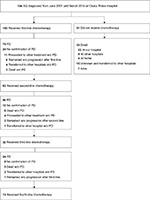  | Figure S1 Patient flowchart. Abbreviations: PD, progressive disease; SQ, squamous cell carcinoma; w/o, without. |
  | Table S1 Laboratory data at diagnosis Notes: aAt the nearest data before diagnostic examination was performed. bUnpaired t-test. Data are presented as mean ± standard deviation. |
  | Table S3 Laboratory data at the start of first- to third-line chemotherapy Notes:aData obtained nearest to the start of each line of chemotherapy. Data are presented as mean ± standard deviation. |
  | Table S4 Regimens Notes: Data are presented as number of patients. Abbreviations: EGFR-TKI, epidermal growth factor receptor-tyrosine kinase inhibitor. |
  | Table S5 Treatment response and discontinuation |
 © 2016 The Author(s). This work is published and licensed by Dove Medical Press Limited. The full terms of this license are available at https://www.dovepress.com/terms.php and incorporate the Creative Commons Attribution - Non Commercial (unported, v3.0) License.
By accessing the work you hereby accept the Terms. Non-commercial uses of the work are permitted without any further permission from Dove Medical Press Limited, provided the work is properly attributed. For permission for commercial use of this work, please see paragraphs 4.2 and 5 of our Terms.
© 2016 The Author(s). This work is published and licensed by Dove Medical Press Limited. The full terms of this license are available at https://www.dovepress.com/terms.php and incorporate the Creative Commons Attribution - Non Commercial (unported, v3.0) License.
By accessing the work you hereby accept the Terms. Non-commercial uses of the work are permitted without any further permission from Dove Medical Press Limited, provided the work is properly attributed. For permission for commercial use of this work, please see paragraphs 4.2 and 5 of our Terms.

